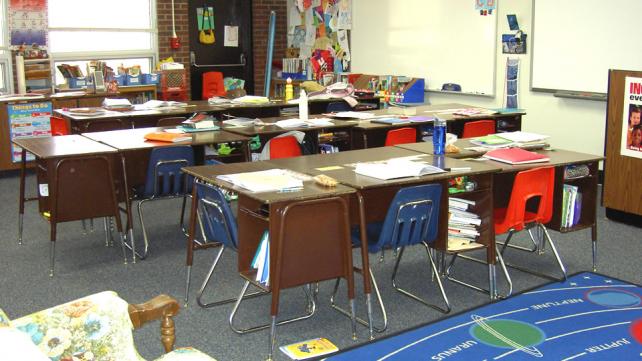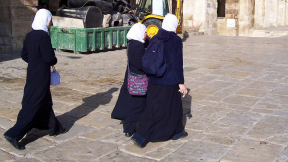
The atmosphere of the classroom has much to do with student behavior. The setting should be appealing, with attention given to varying the physical features and the schedule to prevent boredom in both the teacher and the student.
Teachers should let students know specific do's and don'ts: which behaviors are expected or desired and which will not be tolerated. Then teachers must consistently reinforce the desired behaviors while ignoring or in some other way extinguishing the undesirable ones.
WHAT ABOUT ESTABLISHING RULES?
Some teachers make too many rules, and the children, confused or frustrated, ignore them. Teachers should establish only a few rules and should specify the consequences for not following them.
HOW CAN TEACHERS INCREASE STUDENT MOTIVATION FOR ACADEMIC TASKS?
One approach could be to make one activity contingent on another: students can earn time in one favored activity by performing well in another.
Students having difficulty in one subject area could serve as tutors to younger students in that same skill, dependent upon the older child's satisfactory performance.
Classroom privileges such as helping to distribute papers can also be made contingent on performance.
WHAT ABOUT TOKEN ECONOMIES?
This approach, in which pupils are given a mark for rewards redeemable at a later time, can help students learn. However, token economies are usually costly.
In addition, results of research investigating whether or not performance is maintained after the system is removed have been discouraging.
HOW CAN TEACHERS DECREASE UNWANTED BEHAVIOR?
Teachers can reward a student when a specified behavior does not occur, or when it occurs below a designated frequency or duration level. Overcorrection is another possibility. Teachers instruct students to correct the inappropriate behavior and execute the act within a natural sequence of events.
For example, in one case a child who mouthed objects was told "no" and required to brush his teeth and wipe his lips with a washcloth each time he put a potentially harmful or unhygienic object in his mouth.
WHAT ROLE DOES PUNISHMENT PLAY IN CLASSROOM MANAGEMENT?
Punishment can be defined as a technique that decelerates the frequency of a behavior when it is given contingent on that behavior. Reprimands, frowns, reminders and other subtle expressions can serve as punishment, and can be very effective when used appropriately.
A possible disadvantage of punishment is that its effects may overgeneralize, eliminating more behaviors that originally intended. Another difficulty is that the student might associate the technique with the person who administered it, causing ill feeling toward the teacher.
WHAT ABOUT TAKING SOMETHING AWAY TO DECREASE UNWANTED BEHAVIORS?
Teachers can take away the opportunity to obtain reinforcement, attention, or a portion of some event contingent on target behavior. These three procedures are also known as timeout, extinction, and response cost.
Timeout can involve physically removing a student for short periods from the reinforcing event or area.
Ignoring tantrums is a withdrawal of attention that may lead to extinction of the problem behavior.
Taking away tokens or points for disobeying rules is an example of response cost.
IF A TEACHER CAN'T CONCENTRATE ON INDIVIDUAL PROBLEMS, ARE THERE GROUP METHODS THAT WILL WORK?
*Independent group contingencies. Each student receives the same consequence for stated behavior, as in staying after class for out-of-seat behavior. Although easy to administer, this approach does not take into account individual student differences.
*Dependent group contingency. The same consequence is given to all members of a group. In order to receive the consequence, a selected member must perform at or better than a specified level. One student's behavior can influence the group's consequence. This approach can improve peer group behavior at the same time.
A program in which a student accumulates free time for the entire class by on-task behavior may encourage fellow students to support his appropriate activity and not engage him in off-task interaction.
*Group consequence, contingent on group. The entire class is considered as one group. An example is making free time dependent on appropriate behavior: an individual's inappropriate activity reduces the entire class's reward.
This approach might be effective when several individuals are behaving inappropriately. However, repercussions might occur if group members feel unduly punished due to the behavior of an individual student.
WHAT ARE SOME GENERAL GUIDELINES FOR MANAGING INAPPROPRIATE BEHAVIOR?
- Examine the events that maintain students' behavior.
- Keep data to determine whether or not an approach is working. Compare behavior during baseline and treatment phases.
- Consider a variety of techniques.
- Combine approaches to be more effective. For example, a teacher might praise appropriate behavior while ignoring inappropriate behavior.
- Concentrate on teaching new behaviors and deal with inappropriate ones only to the extent that they interfere with the individual's or group's learning.
The information in this digest is taken from "Managing Inappropriate Behaviors in the Classroom" by Thomas C. Lovitt, Reston, VA: The Council for Exceptional Children, 1978, 44 pp. (ED 157 255)
RESOURCES
- Cheney, C. O. (1989). "Preventative discipline through effective classroom management." 15 pp. Reno, NV: University of Nevada. (ED 304 689) This document is reproduced in its entirety in "Preventive Discipline and Behavior Management," Computer Search Reprint C572, Reston VA: The Council for Exceptional Children, 1989.
- Johnston, L., and others. (1984). "Setting limits: Tips for teachers of young children." Project enlightenment. (ED 293 294)
- Romney, D.M. (1986). "Dealing with abnormal behavior in the classroom. Fastback 245." 42 pp. (ED 275 944) Available from: Phi Delta Kappa Educational Foundation, Eighth and Union, Box 789, Bloomington, IN 47402
- Smith, D.L. (1988). "Preparing teachers for classroom management decisions using simulated open-ended video vignettes." 11 pp. (ED 290 729)
- Wolfgang, C.H., & Glickman, C.D. (1986). "Solving discipline problems: Strategies for classroom teachers." Second Edition. 330 pp. (ED 216 788)
- ERIC Digests are in the public domain and may be freely reproduced and disseminated.
- This publication was prepared with funding from the Office of Educational Research and Improvement, U.S. Department of Education, under contract no. RI88062007. The opinions expressed in this report do not necessarily reflect the positions or policies of OERI or the Department of Education.








Comments
excellent resources and excellent and useful article.
Location
Add new comment